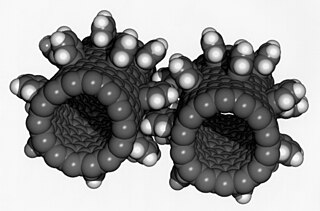Related Research Articles

Computational chemistry is a branch of chemistry that uses computer simulations to assist in solving chemical problems. It uses methods of theoretical chemistry incorporated into computer programs to calculate the structures and properties of molecules, groups of molecules, and solids. The importance of this subject stems from the fact that, with the exception of some relatively recent findings related to the hydrogen molecular ion, achieving an accurate quantum mechanical depiction of chemical systems analytically, or in a closed form, is not feasible. The complexity inherent in the many-body problem exacerbates the challenge of providing detailed descriptions of quantum mechanical systems. While computational results normally complement information obtained by chemical experiments, it can occasionally predict unobserved chemical phenomena.

Nanotechnology is the manipulation of matter with at least one dimension sized from 1 to 100 nanometers (nm). At this scale, commonly known as the nanoscale, surface area and quantum mechanical effects become important in describing properties of matter. This definition of nanotechnology includes all types of research and technologies that deal with these special properties. It is common to see the plural form "nanotechnologies" as well as "nanoscale technologies" to refer to research and applications whose common trait is scale. An earlier understanding of nanotechnology referred to the particular technological goal of precisely manipulating atoms and molecules for fabricating macroscale products, now referred to as molecular nanotechnology.

In biology and other experimental sciences, an in silico experiment is one performed on a computer or via computer simulation software. The phrase is pseudo-Latin for 'in silicon', referring to silicon in computer chips. It was coined in 1987 as an allusion to the Latin phrases in vivo, in vitro, and in situ, which are commonly used in biology. The latter phrases refer, respectively, to experiments done in living organisms, outside living organisms, and where they are found in nature.

Nitya Anand was an Indian medicinal chemist who was the director of Central Drug Research Institute in Lucknow from 1974 to 1984. In 2005, Indian Pharmacopoeia Commission (IPC) appointed him chairman of its scientific committee. In 2012, he was awarded the Padma Shri by the Indian government.

Sathyabama Institute of Science and Technology (SIST), formerly Sathyabama University, is a private, multi-disciplinary deemed university in Chennai, Tamil Nadu, India. Established in 1987, it is accredited with the 'A++' grade by NAAC and is a 'Category 1 University' under the UGC. It has also received its ISO 9001:2008 certification. The 140-acres campus features both traditional buildings and modern infrastructure, including a research hospital, aeronautical hangars and an advanced nanotechnology centre. The institute has the distinction of being one of the few universities in India to have successfully built and launched its own space satellite, in association with ISRO.

DNA origami is the nanoscale folding of DNA to create arbitrary two- and three-dimensional shapes at the nanoscale. The specificity of the interactions between complementary base pairs make DNA a useful construction material, through design of its base sequences. DNA is a well-understood material that is suitable for creating scaffolds that hold other molecules in place or to create structures all on its own.
The Sackler Prize is named for the Sackler family and can indicate any of the following three awards established by Raymond Sackler and his wife Beverly Sackler currently bestowed by the Tel Aviv University. The Sackler family is known for its role in the opioid epidemic in the United States, has been the subject of numerous lawsuits and critical media coverage, and been dubbed the "most evil family in America", and "the worst drug dealers in history". The family has engaged in extensive efforts to promote the Sackler name, that has been characterized as reputation laundering. In 2023 the Sackler family's name was removed from the name of the Tel Aviv University Faculty of Medicine. The 2024 prize winners responded by demanding that the prize be renamed.

Jonathan S. Dordick is an institute professor of chemical and biological engineering at Rensselaer Polytechnic Institute and holds joint appointments in the departments of biomedical engineering and biological sciences. In 2008 he became director of the Center for Biotechnology and Interdisciplinary Studies. In 2012 Dordick became the vice president for research at RPI. He became Special Advisor to the RPI President for Strategic Initiatives in 2018,
ChemSpider is a freely accessible online database of chemicals owned by the Royal Society of Chemistry. It contains information on more than 100 million molecules from over 270 data sources, each of them receiving a unique identifier called ChemSpider Identifier.

Omar M. Yaghi is the James and Neeltje Tretter Chair Professor of Chemistry at the University of California, Berkeley, an affiliate scientist at Lawrence Berkeley National Laboratory, the Founding Director of the Berkeley Global Science Institute, and an elected member of the US National Academy of Sciences as well as the German National Academy of Sciences Leopoldina.
The Dr. Paul Janssen Award for Biomedical Research is given annually by Johnson & Johnson to honor the work of an active scientist in academia, industry or a scientific institute in the field of biomedical research. It was established in 2004 and perpetuates the memory of Paul Janssen, the founder of Janssen Pharmaceutica, a Johnson & Johnson subsidiary.
Richard A. Houghten is a heterocyclic organic chemist and founder of the journal Peptide Research, which was later merged with the International Journal of Peptide and Protein Research, to become the Journal of Peptide Research. His work mainly concerns peptide activity and pharmacology. He is the founder and president of the Torrey Pines Institute for Molecular Studies (TPIMS), a biomedical research institute. Houghten pioneered the "tea-bag" approach of producing peptides for pharmacological work.
Southern Research is a not-for-profit US 501(c)(3) research organization that conducts basic and applied research for commercial and non-commercial organizations across four divisions: Drug development, Drug discovery, Energy & Environment, and Engineering.

Ram Samudrala is a professor of computational biology and bioinformatics at the University at Buffalo, United States. He researches protein folding, structure, function, interaction, design, and evolution.

Garikapati Narahari Sastry is an Indian Chemist and a Professor at the Department of Biotechnology at IIT-Hyderabad. He served as Director of CSIR- North East Institute of Science and Technology, Jorhat Jorhat, Assam from 19 February 2019 and served there till 10 January 2024. After taking charge as the Director, he has worked towards converting knowledge in the areas of computational modelling and Artificial intelligence from basic to translational research, by working closely with society and industry. Ultimately, revitalizing the strength of science and technology is essential in achieving the self-reliant and strong India. In the era of Industry 4.0 and 5.0, combining our traditional wisdom with modern science appear to be indispensable in the sectors such as Education, Health, Agriculture, Industrial and Societal development at large. Prior to joining as the Director, he headed the Molecular Modelling Division at the CSIR Indian Institute of Chemical Technology in Hyderabad, India. Sastry has made pioneering contributions in the areas of computational chemistry and computational biology.

Paula Therese Hammond is an Institute Professor and the Vice Provost for Faculty at the Massachusetts Institute of Technology (MIT). She was the first woman and person of color appointed as head of the Chemical Engineering department. Her laboratory designs polymers and nanoparticles for drug delivery and energy-related applications including batteries and fuel cells.
Curia is a contract research and manufacturing organization that provides drug discovery, development, cGMP manufacturing and aseptic fill and finish to the pharmaceutical and biotechnology industries. Founded in 1991, Curia operates in the United States, Europe and Asia, with its headquarters located in Albany, New York. Curia has announced deals and collaborations with such companies as Pfizer Inc., Merck & Co., Eli Lilly and Company, Takeda, Genentech, Bristol-Myers Squibb Co. and GE.

Ziv Bar-Joseph is an Israeli computational biologist and Professor in the Computational Biology Department and the Machine Learning Department at the Carnegie Mellon School of Computer Science.

Building block is a term in chemistry which is used to describe a virtual molecular fragment or a real chemical compound the molecules of which possess reactive functional groups. Building blocks are used for bottom-up modular assembly of molecular architectures: nano-particles, metal-organic frameworks, organic molecular constructs, supra-molecular complexes. Using building blocks ensures strict control of what a final compound or a (supra)molecular construct will be.
Artificial intelligence in pharmacy is the application of artificial intelligence (AI) to the discovery, development, and the treatment of patients with medications. AI in pharmacy practices has the potential to revolutionize all aspects of pharmaceutical research as well as to improve the clinical application of pharmaceuticals to prevent, treat, or cure disease. AI, a technology that enables machines to simulate human intelligence, has found applications in pharmaceutical research, drug manufacturing, drug delivery systems, clinical trial optimization, treatment plans, and patient-centered services.
References
- ↑ "An algorithmic framework for synthetic cost-aware decision making in molecular design". arxiv.org. Retrieved 2024-07-20.
- ↑ "A smarter way to streamline drug discovery". MIT News | Massachusetts Institute of Technology. 2024-06-17. Retrieved 2024-07-20.